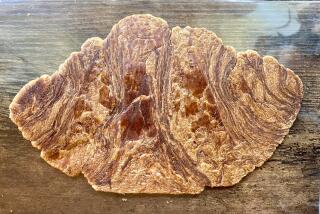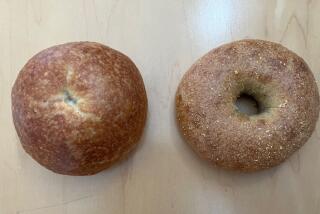Why bread gets stale, and why that can be a good thing
When it comes to bread, staling is one of a cook’s worst enemies. Within only a couple of days, it can turn a perfect loaf into lead — and refrigerating that bread only makes things worse.
But staling also can be a great help. Fried rice? Rice or potato salads? Mashed potatoes? Bread pudding? They’re all better if you take advantage of the staling process.
Though it may appear that staling is the same thing as drying, it’s actually more complicated. Basically, staling happens when starches have been moistened, heated and cooled. This changes the crystalline form of the starch granules — they go from hard to soft and then back to hard again, but in a different form than they started.
This happens much more rapidly at moderately cold temperatures. One group of Spanish scientists analyzed bread staling at different temperatures and found that it was worst at 40 degrees. Which is almost exactly the base temperature for most home refrigerators.
Paradoxically, more cold is better. Freezing delays staling. And, to a limited extent, reheating cures it. Toasting stale bread makes it more edible, if not perfect, as long as the staling hasn’t gone too far and as long as you eat it right away.
Scientists call this staling process retrogradation, and there’s quite a lot of research that has been done on it, particularly as it applies to bread.
For a good layman’s primer, see the recent Serious Eats post by Daniel Gritzer. For something a little more geeky, try Emily Buehler’s FoodChemBlog post on stale bread. If you want something more in-depth, there’s a good post on the Dutch site Bakery Technology (don’t worry, it’s translated into English).
Even though retrogradation is a curse for the bread baker, it can be useful too. For example, have you ever tried to fry rice when it has been freshly cooked? Nasty, right? Sticky, gummy and mushy.
There’s a reason you refrigerate rice overnight before frying it. And that reason is retrogradation. When cooked rice is chilled, the outer starch shell hardens, keeping the grains light and separate when you re-heat them.
The same thing happens when you make a rice salad — though for this you’ll want to dress the rice lightly before chilling. Once that shell hardens, it also reduces the amount of flavoring the rice will absorb.
And the same thing happens when you make a potato salad. Ever wondered why the texture of a warm potato salad is so different from one served cold? Again though, be sure to dress the potatoes lightly before cooling — just a sprinkling of vinegar will do the trick.
If you’re interested in pursuing graduate-level work on starch retrogradation, try making mashed potatoes by chilling cooked spuds before whipping in the butter and cream.
As Jeffrey Steingarten found and described in his book “The Man Who Ate Everything,” chilling cooked potato slices before reheating and pureeing them will help prevent the mashed potatoes from becoming gummy, no matter how vigorously you stir them. (This is true only to a limited extent, and only with very careful cooking — you want to maintain the water at 160 degrees, well below a simmer, during the initial cooking.)
Back to stale bread: This byproduct of retrogradation is also why stale bread is better for making bread puddings, bread salads and French toast.
Are you a food geek? Follow me on Twitter @russ_parsons1
More to Read
Eat your way across L.A.
Get our weekly Tasting Notes newsletter for reviews, news and more.
You may occasionally receive promotional content from the Los Angeles Times.







